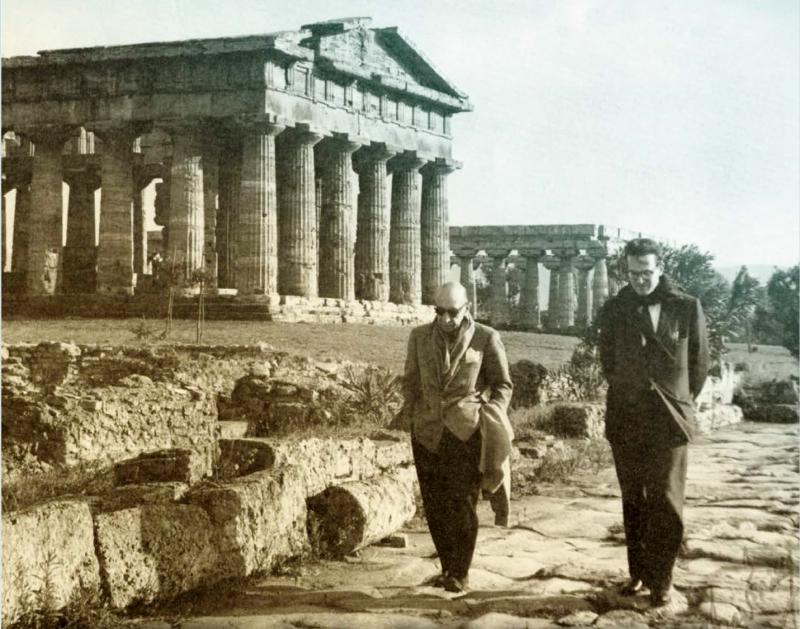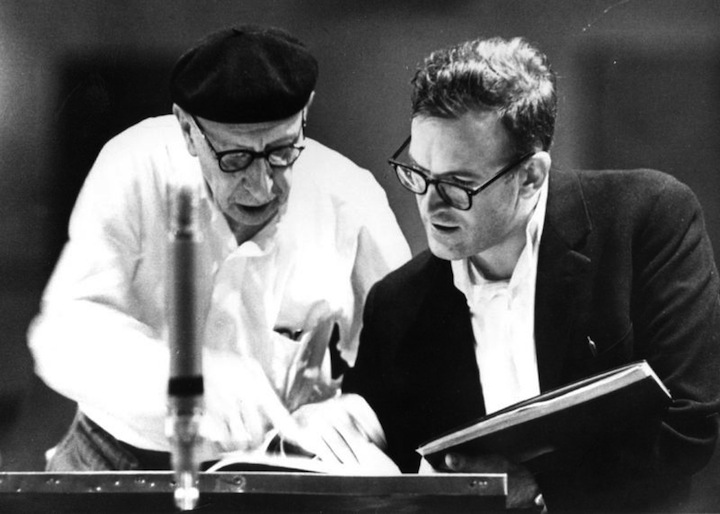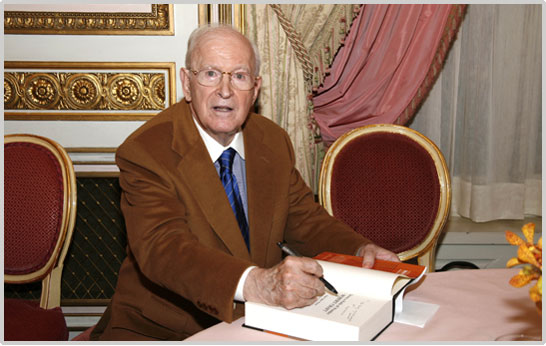Farewell to Stravinsky's right-hand man | reviews, news & interviews
Farewell to Stravinsky's right-hand man
Farewell to Stravinsky's right-hand man
Robert Craft, great Igor's guide to old and new music, has died at the age of 92

Missionary angel or twelve-tone devil? Musical figures like Poulenc, perhaps too much attached to the diabolical element in Thomas Mann’s Doktor Faustus, were inclined to see the incursion of Robert Craft into Stravinsky’s Hollywood life in 1948 in demonic terms.
Yet both Craft and Stravinsky’s wife, Vera, witnessed the great man break down tearfully in 1952 and declare he could no longer compose; Craft was to be his saviour. Stravinsky had pioneered a new rhythmic dynamism and a cubist approach to folksong in The Rite of Spring back in 1913; he had taken most previous styles in music and adapted them as his own for the previous three decades. Yet in his seventies he reinvented himself through a careful appraisal of what twelve-tone music could mean to him: “I do as I wish in the scale or mode I prefer…I am also able to write in a series… if I want to. But I do not have to." A steady adoption of strict serialism does inform the procession of later works, though. That probably wouldn’t have happened without Craft, who moved into North Wetherly Drive, sorted out Stravinsky’s manuscripts, fllled his library with English-language classics, and discussed his own musical passions with the composer, bearing them out in performance where possible.
 For Craft was also a conducting pioneer for very old as well as very new. In some of the bracing Los Angeles Monday Evening Concerts, he introduced the music of the late renaissance prince Carlo Gesualdo, master of arcane harmonies in tonal contexts, to his audiences (Boulez was tending to much the same mix in his Domaine Musical series). The work of his Gesualdo Madrigalists, with Marilyn Horne as second soprano, has just resurfaced in a huge Sony box devoted to Stravinsky’s complete Columbia recordings, with satellite works very much present. It was to Craft that Stravinsky dedicated his Monumentum pro Gesualdo, translating human voices into singing groups of instruments. And so in his last years he was still keeping one foot in a past even more distant than the world of Bach, whom he worshipped.
For Craft was also a conducting pioneer for very old as well as very new. In some of the bracing Los Angeles Monday Evening Concerts, he introduced the music of the late renaissance prince Carlo Gesualdo, master of arcane harmonies in tonal contexts, to his audiences (Boulez was tending to much the same mix in his Domaine Musical series). The work of his Gesualdo Madrigalists, with Marilyn Horne as second soprano, has just resurfaced in a huge Sony box devoted to Stravinsky’s complete Columbia recordings, with satellite works very much present. It was to Craft that Stravinsky dedicated his Monumentum pro Gesualdo, translating human voices into singing groups of instruments. And so in his last years he was still keeping one foot in a past even more distant than the world of Bach, whom he worshipped.
It’s now known that Craft conducted many more of the late recordings attributed to Stravinsky than was acknowledged at the time. But that makes little difference; Stravinsky, unlike Shostakovich, was adamant that his absolute wishes should be adhered to, that there was little room for interpretation, and these sessions would have been the result of the closest collaboration.
 More recent recordings by Craft (pictured left at a book-signing) for the Naxos label show precision and some top-quality musicianship from the Phiharmonia and the Orchestra of St Luke’s; few other conductors have cared to champion thorny late pieces like Threni for recorded posterity. When Deutsche Grammophon, co-opting Decca and Philips in the same stable, produced its own 30-CD box it stil had to turn to Craft to fill the gaps and make its works complete.
More recent recordings by Craft (pictured left at a book-signing) for the Naxos label show precision and some top-quality musicianship from the Phiharmonia and the Orchestra of St Luke’s; few other conductors have cared to champion thorny late pieces like Threni for recorded posterity. When Deutsche Grammophon, co-opting Decca and Philips in the same stable, produced its own 30-CD box it stil had to turn to Craft to fill the gaps and make its works complete.
How much of the five-volume treasure trove devoted to Stravinsky’s opinions as voiced to his amanuensis is Craft’s work or invention will probably never be known, but the quintet is a mighty entertaining read. In the second of two later books of his own, Stravinsky: Discoveries and Memories (2013), he caused a ruckus with his “revelation” of the composer’s “ambisexual” phase around The Rite of Spring, citing sexual relationships with Nikolay Rimsky-Korsakov’s son Andrey and composer Maurices Ravel and Delage. Opponents claim insufficient scholarly evidence, and this has been a bone throughout – surprising for a man so exacting in his adherence to the word of the Father Stravinsky. Scholarly wranglngs may go on long after his death, but Craft is an indelible part of music history, and absolutely central when it came to the late masterpieces of Igor Stravinsky.
- David Nice's introduction to Stravinsky in the Naxos Portrait series comes with two CDS including excerpts from many of Craft's recordings
Explore topics
Share this article
The future of Arts Journalism
You can stop theartsdesk.com closing!
We urgently need financing to survive. Our fundraising drive has thus far raised £49,000 but we need to reach £100,000 or we will be forced to close. Please contribute here: https://gofund.me/c3f6033d
And if you can forward this information to anyone who might assist, we’d be grateful.

Subscribe to theartsdesk.com
Thank you for continuing to read our work on theartsdesk.com. For unlimited access to every article in its entirety, including our archive of more than 15,000 pieces, we're asking for £5 per month or £40 per year. We feel it's a very good deal, and hope you do too.
To take a subscription now simply click here.
And if you're looking for that extra gift for a friend or family member, why not treat them to a theartsdesk.com gift subscription?
more Classical music
 Jansen, LSO, Pappano, Barbican review - profound and bracing emotional workouts
Great soloist, conductor and orchestra take Britten and Shostakovich to the edge
Jansen, LSO, Pappano, Barbican review - profound and bracing emotional workouts
Great soloist, conductor and orchestra take Britten and Shostakovich to the edge
 Jakub Hrůša and Friends in Concert, Royal Opera review - fleshcreep in two uneven halves
Bartók kept short, and a sprawling Dvořák choral ballad done as well as it could be
Jakub Hrůša and Friends in Concert, Royal Opera review - fleshcreep in two uneven halves
Bartók kept short, and a sprawling Dvořák choral ballad done as well as it could be
 Hadelich, BBC Philharmonic, Storgårds, Bridgewater Hall, Manchester review - youth, fate and pain
Prokofiev in the hands of a fine violinist has surely never sounded better
Hadelich, BBC Philharmonic, Storgårds, Bridgewater Hall, Manchester review - youth, fate and pain
Prokofiev in the hands of a fine violinist has surely never sounded better
 Monteverdi Choir, ORR, Heras-Casado, St Martin-in-the-Fields review - flames of joy and sorrow
First-rate soloists, choir and orchestra unite in a blazing Mozart Requiem
Monteverdi Choir, ORR, Heras-Casado, St Martin-in-the-Fields review - flames of joy and sorrow
First-rate soloists, choir and orchestra unite in a blazing Mozart Requiem
 Cho, LSO, Pappano, Barbican review - finely-focused stormy weather
Chameleonic Seong-Jin Cho is a match for the fine-tuning of the LSO’s Chief Conductor
Cho, LSO, Pappano, Barbican review - finely-focused stormy weather
Chameleonic Seong-Jin Cho is a match for the fine-tuning of the LSO’s Chief Conductor
 Classical CDs: Shrouds, silhouettes and superstition
Cello concertos, choral collections and a stunning tribute to a contemporary giant
Classical CDs: Shrouds, silhouettes and superstition
Cello concertos, choral collections and a stunning tribute to a contemporary giant
 Appl, Levickis, Wigmore Hall review - fun to the fore in cabaret and show songs
A relaxed evening of light-hearted fare, with the accordion offering unusual colours
Appl, Levickis, Wigmore Hall review - fun to the fore in cabaret and show songs
A relaxed evening of light-hearted fare, with the accordion offering unusual colours
 Lammermuir Festival 2025, Part 2 review - from the soaringly sublime to the zoologically ridiculous
Bigger than ever, and the quality remains astonishingly high
Lammermuir Festival 2025, Part 2 review - from the soaringly sublime to the zoologically ridiculous
Bigger than ever, and the quality remains astonishingly high
 BBC Proms: Ehnes, Sinfonia of London, Wilson review - aspects of love
Sensuous Ravel, and bittersweet Bernstein, on an amorous evening
BBC Proms: Ehnes, Sinfonia of London, Wilson review - aspects of love
Sensuous Ravel, and bittersweet Bernstein, on an amorous evening
 Presteigne Festival 2025 review - new music is centre stage in the Welsh Marches
Music by 30 living composers, with Eleanor Alberga topping the bill
Presteigne Festival 2025 review - new music is centre stage in the Welsh Marches
Music by 30 living composers, with Eleanor Alberga topping the bill
 Lammermuir Festival 2025 review - music with soul from the heart of East Lothian
Baroque splendour, and chamber-ensemble drama, amid history-haunted lands
Lammermuir Festival 2025 review - music with soul from the heart of East Lothian
Baroque splendour, and chamber-ensemble drama, amid history-haunted lands
 BBC Proms: Steinbacher, RPO, Petrenko / Sternath, BBCSO, Oramo review - double-bill mixed bag
Young pianist shines in Grieg but Bliss’s portentous cantata disappoints
BBC Proms: Steinbacher, RPO, Petrenko / Sternath, BBCSO, Oramo review - double-bill mixed bag
Young pianist shines in Grieg but Bliss’s portentous cantata disappoints

Add comment